

Each has a particular meaning or purpose. Most often the answer to these questions is "you can't." There are a set of unicode ranges that correspond to combining characters. I'm not an expert on this subject, but it seems like your question falls into a common category, which could be summarized as "I want to replicate the behavior of this (set of) unicode character(s) for a different purpose.

#SETTING UP REFERENCE PHOTO IN FONTFORGE HOW TO#
I tried looking at fontforge, but I couldn't figure out how to use "unicode combining character" to achieve what I want.Īnyone know if it's possible to do what I want at all, and if yes, if I can do it in fontforge? The kitty developer however said: " If you want to combine to characters into another, you should use a unicode combining character for that, then kitty will convert char+combining char into a single cell glyph." In qterminal and in a qutebrowser, the string shows up normally as "¡c". However using ligatures, one of the terminals supporting them called kitty is showing the string "abc" appear as "¡ c" instead of "¡c" as the ligature reserves two cells in that program. With the help of ligatures and the tutorial to them in fontforge at I was able to create a test font that substitutes "ab" to "¡". So "ba" "be" "bi" "bo" etc would have their own glyphs, and "bab" would be "ba"+"b". The alphabet will have all the consonants and vowels from latin alphabets, but the consonants that are followed by vowels would appear as single cell glyph. I am looking into creating a font that will have custom alphabet. The compose/decompose thing in the lookups seemed to work just like creating a ligature and behaved similarly but. I just want to know how to make unicode combining characters in fontforge. I know this isn't probably the right place to ask this, but I wasn't allowed to post into reddit r/fontforge ,and my experience with mailing lists is something that I wish to avoid as much as possible.


 0 kommentar(er)
0 kommentar(er)
